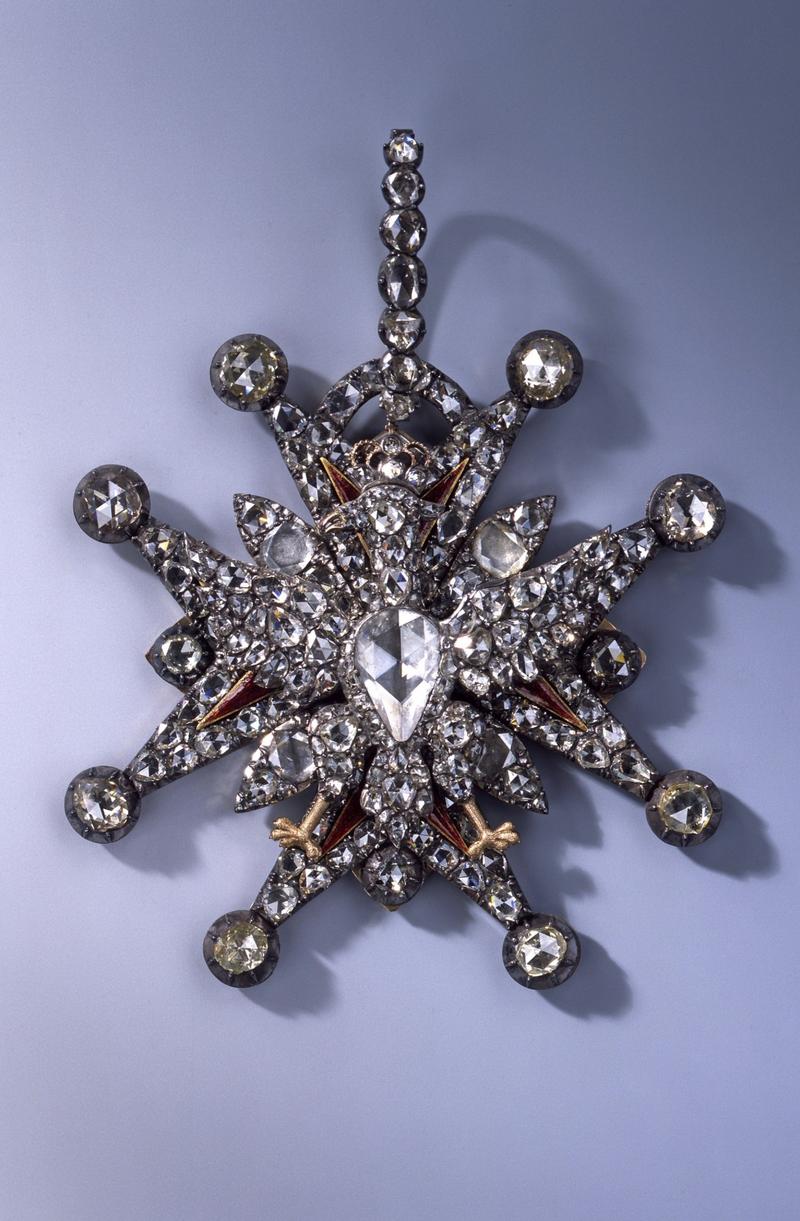 This undated photo provide by the State Art Collection in Dresden on Nov 25, 2019 shows an jewel of the Polish White Eagle Order that were stolen from the Green Vault early Nov 25, 2019 morning in Dresden, Germany. (STAATLICHE KUNSTSAMMLUNGEN DRESDEN / JUERGEN KARPINSKI VIA AP)
This undated photo provide by the State Art Collection in Dresden on Nov 25, 2019 shows an jewel of the Polish White Eagle Order that were stolen from the Green Vault early Nov 25, 2019 morning in Dresden, Germany. (STAATLICHE KUNSTSAMMLUNGEN DRESDEN / JUERGEN KARPINSKI VIA AP)
Thieves who made off with a "priceless" haul of diamond-encrusted treasures from a museum in Germany on Monday may have already melted down metals and recut precious stones in an attempt to make their distinctive booty easier to sell, experts have warned.
Christopher Marinello, the founder of Art Recovery International, told the BBC that museums housing artifacts containing precious materials are "under siege by barbarian criminal gangs who melt down gold and carve out precious stones with no regard to the importance of cultural heritage".
This is a major collection of jewels and intact designs containing gold, diamonds, precious gems and rubies
Christopher Marinello, the founder of Art Recovery International
He said the raid on the Dresden Green Vault, in which thieves made off with diamond-bedecked swords and brooches, was "a theft of epic proportions".Marinello said: "This is a major collection of jewels and intact designs containing gold, diamonds, precious gems and rubies. I knew exactly what was going to happen once I heard what was taken - that we were not going to see these items remain intact."
He said the items, which were collected in the early 1700s by Saxony's ruler, Augustus the Strong, are so distinctive, thieves will break them down to their component parts.
The German newspaper Bild estimated that the uninsured collection housed in the former palace was worth 1 billion euros (US$1.1 billion).
Profiler and author Alex Petermann, told the paper: "The perpetrators proceeded meticulously, had technical know-how and certainly insider knowledge." He too said the collection will likely be dismantled.
The regional Saechsische Zeitung newspaper quoted Green Vault director Dirk Syndram as being incredulous that the thieves had been able to circumvent the alarm system.
"Our security system was checked four years ago with the result that everything was tiptop," he said. "It was almost like Mission Impossible what they did there."
The head of Dresden's state museums, Marion Ackermann, told the BBC the idea of items being lost forever was horrific.
 This undated photo provide by the State Art Collection in Dresden on Nov 25, 2019, shows a jewel in palmette shape that were stolen from the Green Vault early Nov 25, 2019 morning in Dresden, Germany. (STAATLICHE KUNSTSAMMLUNGEN DRESDEN / JUERGEN KARPINSKI VIA AP)
This undated photo provide by the State Art Collection in Dresden on Nov 25, 2019, shows a jewel in palmette shape that were stolen from the Green Vault early Nov 25, 2019 morning in Dresden, Germany. (STAATLICHE KUNSTSAMMLUNGEN DRESDEN / JUERGEN KARPINSKI VIA AP)
ALSO READ: Priceless items stolen from Dresden's Green Vault museum
"We are talking here about items of inestimable art-historical and cultural-historical value," she said. "We cannot put an exact value on them because they are priceless."
Police believe the thieves got into the museum by smashing their way through a window after a fire had disabled the power supply and, therefore, the alarm system. The thieves seem to have been selective, taking many items but leaving others behind.
Saxony's art minister, Eva-Maria Stange, said the items were "to a certain extent the crown jewels of the Saxon kings".
She said she wants them returned intact to the German state.
And Saxony's interior minister, Roland Woller, told German media: "This is a bitter day for the cultural heritage of Saxony. The thieves stole cultural treasures of immeasurable worth - that is not only the material worth but also the intangible worth to the state of Saxony, which is impossible to estimate."
The Guardian newspaper noted police were at the scene of the robbery within Dresden's Royal Palace within minutes. A car that investigators believe the thieves used to make their escape was later found burned in Dresden.
The Dresden Green Vault is one of the oldest museums in Europe and has been a tourist attraction since 1724. It comprises 10 rooms containing around 3,000 pieces of jewelry and art.
READ MORE: Saudi princess says jewels worth US$900,000 stolen from Paris Ritz
Items on display there include a 64-centimeter-tall figurine studded with emeralds, and a 548-carat sapphire that had belonged to Czar Peter I of Russia.


